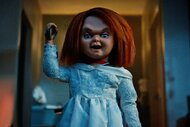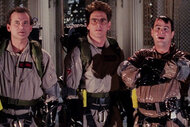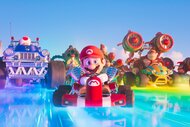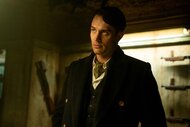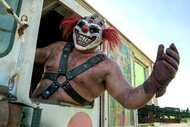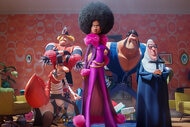Create a free profile to get unlimited access to exclusive videos, sweepstakes, and more!
The ride's over: The 15 greatest defunct Disney attractions you still dream about

This year, as the world reels from the effects of the coronavirus pandemic, we will be robbed of a key summertime activity: attending one of the Disney Parks. (Indeed, this is the longest the Disney Parks have ever been closed.) As we endlessly watch videos online of our favorite rides, shows, and attractions, we’ve also become even more nostalgic about the rides that came before and are no longer open at all.
Even when Disneyland and Walt Disney World open their gates, we still won’t be able to climb aboard.
So it’s with that spirit in mind that we look back at 15 of our most dearly beloved (and badly missed) Disney attractions, from both Disneyland and Walt Disney World.
01. Horizons (1983 – 1999)
Although it opened a full year after the rest of what was then known as EPCOT Center, Horizons for many is emblematic of classic EPCOT and stood as a keystone attraction of what was then a park dedicated to science and discovery. Conceived as a kind of follow-up/sequel to the Carousel of Progress, the 1964 World’s Fair attraction that would become a Disney staple (it still operates daily at the Magic Kingdom); it was designed in conjunction with its corporate sponsor GE as an ode to utopian futurism.
At the heart of the attraction was an Omnimover ride system like that in The Haunted Mansion, only this time it was combined with a number of state-of-the-art technological flourishes, including two 70mm “OMNIMAX” screens and, during the final portion of the nearly 15-minute-long (!) attraction, the ability to choose which future you’d like to see — either the desert community of Mesa Verde, the cosmic outpost of space station Bravo Centauri or the undersea habitat of the Sea Castle research base. It was a trip. Not only did it boldly encompass the hopeful vision of the future that EPCOT Center promoted but it was also one of the most gorgeous, complex attractions Walt Disney Imagineering ever dreamed up — philosophically rich and full of astounding show scenes.
The reasons for its closure remained obscure; some blamed it on the lack of corporate sponsorship (GE stopped sponsoring in 1993) for its decline while others have suggested a massive sinkhole underneath the pyramidal show building was the culprit. Whatever the reason, Horizons quietly closed in 1999 and was later replaced with the considerably lousier Mission: Space in 2003.
Still, Horizons continues to fill those who experienced it with wonder and awe and has become something of a fan favorite defunct attraction in the Disney community, inspiring countless videos (like this very sweet documentary about friends who loved the attraction so much they would get off their ride vehicles and hang out in the sets). And, yes, that robot butler still shows up on merchandise every once in a while.
02. ExtraTERRORestrial Alien Encounter (1994 – 2003)
In the '80s, Disney acquired the theme park rights to the Alien franchise, ostensibly for an attraction dubbed Nostromo that would utilize the shooting mechanics that would eventually be used for Buzz Lightyear’s Space Ranger Spin. (The Alien license would be used as part of the Great Movie Ride, as seen below.) But the idea of a scary ride in the dark persisted, and when Imagineers were conceiving their ambitious redo of Tomorrowland, dubbed Tomorrowland 2055, they knew one of the centerpiece attractions would be this scary experience.
Taking over the space that had been utilized for Mission to Mars, Imagineering teamed with Star Wars creator George Lucas (who had worked on Star Tours and Captain EO) to create the story of what happens when a deadly alien beast is accidentally transported to the middle of the “Tomorrowland Interplanetary Convention Center,” where all hell breaks loose. Alien Encounter, as it’s known to fans, had a rough go. It had a soft opening that was plagued with difficulties, as guests felt the cheery pre-show clashed violently with the actual attraction and with complaints from Michael Eisner that it wasn’t scary enough. When it finally opened, it had a more sinister pre-show (Tim Curry replaced Phil Hartman) and was properly frightening. And that was always the knock against it — that in the midst of Tomorrowland, which envisioned a thrilling (but still rather light-hearted) possibility for the future, it was badly incongruous and did much to break the spell. It also didn’t help that the Tomorrowland 2055 project was ultimately abandoned after the catastrophic opening of what was then known as Euro Disneyland, leaving Alien Encounter its lone remnant in Orlando. (There were even more elaborate plans for the Alien Encounter in Disneyland.)
The attraction, which feels very ahead of its time, made way for Stitch’s Great Escape, which recycled the basic concept and many of the show elements, but made it way, way cuddlier (reel in horror as you smell Stitch’s chili cheese breath!).
Rumors are currently swirling that the building will be repurposed for a new Wreck-It Ralph-based attraction.
03. The Great Movie Ride (1989 – 2017)
This wound is still fresh. The Great Movie Ride, which was the marquee attraction for what was then known as Disney-MGM Studios (now Disney’s Hollywood Studios) in Florida, recently shuttered to make room for Mickey and Minnie’s Runaway Railway. And that is nothing short of a tragedy. When a movies pavilion was still being mulled over for EPCOT Center (before being expanded into its very own park), this was the attraction that would have been there – a slow-moving trip through the history of motion pictures, with an interactive role for cast members that still feels groundbreaking all of these years later, and a host of cutting-edge audio-animatronic figures, most memorably the Wicked Witch of the West from the Wizard of Oz scene. (It also had the aforementioned Alien scene, where a Xenomorph descended from the ceiling and dripped goo on you.)
Utilizing a variation on the “moving theater” ride vehicle from Universe of Energy, guests would glide through a staggering number of dimensional show scenes and, at one point, the cast member guiding you on your tour would be swapped out from a background player from one of the scenes (depending which route you’re on, it’s either an old west bandit or a tough-talking gangster) – the whole trip would take nearly a half hour. The attraction got some much-needed fresh blood when TCM, which occasionally featured nights themed to obscure Disney programming, took over as a sponsor, installing Robert Osborne as another “host” for the Great Movie Ride, although they failed to fix the rotating mechanism from the introductory Footlight Parade scene. Sadly Osborne died a few months before the ride closed, lending the attraction a somewhat ghoulish vibe.
The Great Movie Ride means a great deal to the guests that visited it over the years, offering an educational and exciting journey through the movies. It felt like one of those timeless attractions you’d get to visit every time you were in the park and it’s worth wondering if they had delayed the announcement of its closure, would Disney+ have swooped in as a potential sponsor?
04. World of Motion (1982 – 1996)
The first tenant of the Transportation pavilion at EPCOT Center, World of Motion was another classic first-generation EPCOT attraction — it opened with the rest of the park on October 1, 1982, and told the history of transportation with a mixture of education and entertainment. In fact, the entire building is designed like a wheel and, in a key moment early on in the attraction, you briefly go outside of the building, where you can see a startling view of EPCOT Center Spaceship Earth.
Designed largely by Imagineering legend Ward Kimball, with set to an infectiously catchy theme song by X. Atencio (who also wrote the songs for The Haunted Mansion and Pirates of the Caribbean), this is another cozy jaunt from the past to the future (the final show scene takes you through a futuristic city called CenterCore before you are placed into a futuristic vehicle through an effect similar to the one that closed out The Haunted Mansion). Sponsored by GM, the attraction didn’t feel overly corporate (until you entered the TransCenter, which showcased all of GM’s newest models) and the sweet, funny, 15-minute attraction utilized an Omnimover system like Spaceship Earth and featured some truly memorable show scenes, perhaps most unforgettably the explorer who runs afoul of a sea serpent.
After GM’s initial 10-year commitment to the project, their sponsorship ran from year to year, and in 1996 they decided to shut down the attraction and build something new. GM would sponsor this new attraction, called Test Track, which in its early years did a great job of continuing the spirit of World of Motion with decidedly more intense thrills (the new version, not so much). World of Motion was ultimately too slow and sweet for the adrenaline-seeking 90s Walt Disney World guest, and that’s a shame. It’s beautifully designed and surprisingly inspiring and a testament to the original mission statement of EPCOT Center and its glorious vision of tomorrow.
05. Body Wars (1989 – 2007)
Everybody knows about Star Tours, but there was once another motion simulator ride at Walt Disney World – one that opened before Star Tours, even. And it was called Body Wars. Originally envisioned as a dark ride called The Incredible Journey Within, with a ride system similar to that of Peter Pan’s Flight, that would serve as a follow-up of sorts to Disneyland’s Adventure Thru Inner Space (more on that in a minute), the proposed attraction was deemed too unwieldy. A solution came in the form of the ride simulator technology Imagineering had used for Star Tours (ironically, Star Tours took over the space in Disneyland once used by Adventure Thru Inner Space). Now, guests could be shrunk down to the size of a blood cell and EPCOT Center would finally get its very first thrill ride.
Directed by Leonard Nimoy (he made Three Men & a Baby a big hit for Disney two years before) and featuring performances from Elisabeth Shue and Tim Matheson, the attraction was initially hugely popular but it was also very rough. In fact, 20 seconds were cut from the ride film during a section where your vehicle gets caught in the lungs since the back-and-forth motion was making people sick. In 2001, Met Life stopped sponsoring the Wonders of Life pavilion, which by that point was already being neglected, and Body Wars fell into disrepair before Disney decided to shutter the whole pavilion. (It honestly didn’t help that Body Wars was tucked into the far side of a pavilion that was already kind of out of the way.)
The pavilion’s other big draw, Cranium Command, suffered an even worse fate as, following years of closure, someone stole the attraction’s main animatronic figure. Body Wars wasn’t the best attraction in Disney’s history, but it was a lot of bloody fun and didn’t deserve to have such an inglorious end. At the D23 Expo last year they announced the pavilion would be repurposed into the Play pavilion. We have no idea what that means but we can almost guarantee that it doesn’t involve Elisabeth Shue getting attacked by white blood cells.
06. The Timekeeper (1994 – 2006)
Disney Parks have utilized a proprietary technology called CircleVision 360 since the opening of Disneyland in 1955. It utilizes a nine-camera system that gets a full 360-degree view of its subjects and was used for films like A Tour of the West and America the Beautiful. But The Timekeeper (originally named From Time to Time) marked the first time the technology was used in service of actual narrative. It was also the first to use Audio-Animatronics, with the titular character, a robot character voiced by Robin Williams who guides us on a journey through time. It is exceptionally charming, featuring appearances by Leonardo da Vinci (Franco Nero), H.G. Wells (Jeremy Irons) and Jules Verne (Michel Piccoli) — can you tell that the attraction first debuted at Disneyland Paris?
The Timekeeper debuted as part of the halfhearted revamp of Tomorrowland that also included Alien Encounter, in a space known as the Tomorrowland Metropolis Science Center (located just across the promenade). And for a while it looked like The Timekeeper would be the next big attraction for Disney, one that made its home at every Tomorrowland the world over (by the time Walt Disney World’s version opened, it had already been playing in Paris and Tokyo). It was charming and imaginative and had the intoxicating, Disney-patented combination of technology might and entertainment value. And by the time the attraction opened, Robin Williams had already become Disney royalty thanks to his appearance in Aladdin and another Disney attraction, the Magic of Disney Animation (more on that in a minute).
The Timekeeper felt like a classic way to update Tomorrowland. But it wasn’t meant to be. By 2001, The Timekeeper had entered into seasonal operation and by 2006 it was gone completely (Paris’ shut down in 2002 and Tokyo’s in 2004). The Timekeeper, with its idiosyncratic storyline and characters new and exclusive to the Disney Parks, was replaced with the Monsters Inc. Laugh Floor, which opened in 2007. The attraction is designed as a monster-world comedy club, using technology that allows computer-animated monsters to interact with guests in real-time. It’s cute but lame and totally skippable, lacking in the charm and sophistication of The Timekeeper.
07. Journey Into Imagination (1983 – 1998)
The first attraction that occupied the Imagination pavilion in EPCOT Center opened a few months after the rest of the park, in March 1983. Overseen by Imagineer Tony Baxter, who borrowed ideas from his proposed Discovery Bay expansion of Disneyland, primarily the idea of an imaginative trickster (dubbed the Dreamfinder here) and his companion, the embodiment of creativity, named Figment (voiced memorably by Willow actor Billy Barty).
The 11-minute dark ride, utilizing the familiar OmniMover ride system that was clearly a staple of early EPCOT Center, was full of audio-animatronics, nearly 80 special effects and featured an early, showstopping where you come upon the Dreamfinder in his dream-catching blimp. As your ride vehicle rotates around the blimp and figures, so too does the giant room, giving the illusion that you’re sitting still but everything is in constant motion. In fact, one quarter of the entire ride was spent just on this scene – and it was a doozy, even more so after you realize what an amazing technical accomplishment this giant carousel was (there were actually five scenes of the Dreamfinder and his craft, for all the new guests whose ride vehicles entered the attraction). But it wasn’t the technology that made Journey Into Imagination so special – it was the warmth, the humor, the sing-along sweetness of the attraction’s signature song, “One Little Spark” (written by the legendary Disney songwriting team of Robert and Richard Sherman) – it really did make you feel like anything was possible, especially when you offloaded and went into the ImageWorks, with the iconic (and long-missed) rainbow tunnel or waltzed over to see the latest 3D attraction in the same pavilion. (It used to be that you didn’t have to go outside for the second attraction at all.)
In 1998, the ride was radically reconceived as Journey Into YOUR Imagination; on a threadbare budget Imagineering attempted to update the attraction for modern audiences while also tying it into Honey, I Shrunk the Audience, which opened next door on the same day. Badly miscalculated and lacking in all of the things that made the first version of the attraction such a classic. After receiving a truly withering response from guests, the ride went down again (after only two years in operation) and was revamped for a third time. This iteration reinstated Figment (now voiced by Dave Goelz) but still had to deal with its cheap-o aesthetic and drastically shortened track. The attraction is now half the length of the original. Talk about a lack of imagination.
08. The Studio Backlot Tour (1989 – 2014)
Back when Disney-MGM Studios (as it was known) opened its doors in May 1989, it was meant to primarily be a working studio — a place where television shows and movies were constantly in production. (Early park maps would list what was shooting that day.) As for the theme park side of things, initial offerings were pretty anemic, with two main attractions being the Great Movie Ride and the Studio Backlot Tour, an over two-hour tour that combined a tram tour through memorable sets and props, with a stop off at the man-made disaster area Catastrophe Canyon and a walking tour, which had you touring the various production facilities as well as the custom-built satellite animation studio (known later as the Magic of Disney Animation), and getting a behind-the-scenes look at everything from weather effects to greenscreen (with a scene from Honey, I Shrunk the Kids as an example — if you were picked you got to ride the giant bee).
Everything about this experience was insane and amazing. This was an attraction where you got to walk by props from Who Framed Roger Rabbit (including a photo op with the Dip Machine), get nearly drenched by gallons of runaway water, and watch animators working on soon-to-be-classics like Beauty and the Beast or The Lion King. For young film fans, it was nirvana, differing from the Universal Backlot Tour in its commitment to theming and highly immersive detail (also the Universal Backlot Tour didn’t cruise by the Golden Girls house, now did it?) The animation section of the tour even had a to-die-for short film called Back to Neverland, which co-starred Robin Williams, and an incredible intro for a studio sizzle reel that featured Michael Eisner asking the Chernabog from Fantasia to sit down.
Eventually, the Studio Backlot Tour was shortened and on its own, while the Magic of Disney Animation became its own attraction. It puttered along, even as the original concept of Disney-MGM as a full-service production facility fell away (the animation studio, long-serving as the heart of the production efforts and the park in general, was shuttered in 2004). Eventually, the area the Studio Backlot Tour occupied was replaced with Toy Story Land and Star Wars: Galaxy’s Edge.
09. America Sings (1974 – 1988)
When the Carousel of Progress, one of four attractions Walt Disney supervised for the 1964 World’s Fair, was moved to the recently opened Magic Kingdom at Walt Disney World, a new attraction was needed for the Carousel Theater in Disneyland. And America Sings, an animal-filled musical revue that was timed to the Bicentennial Celebration of 1976, fit the bill, even though it had literally nothing to do with Disneyland. Written and designed primarily by Disney legend Marc Davis, reusing a number of ideas developed initially for a feature-length animated film called Chanticleer (based on the play by Edmond Rostand), and utilizing the moving theater mechanism designed for Carousel of Progress by Bob Gurr, It was hosted by a talkative eagle named Sam (voiced by Burl Ives), who showcased the changing styles of American music through the decades – sharing both the emphasis on Americana and the passage of time structure with Carousel of Progress. (The cartoony, all-animal cast was reminiscent of the Country Bear Jamboree, an opening day attraction at Florida’s Magic Kingdom.)
The attraction was an audio-animatronic extravaganza, with 115 singing figures, made all the more impressive by the fact that it was completed less than a year after Carousel of Progress closed. Of course, the attraction was not without controversy, as an early song was deemed culturally offensive and a dog with an exaggerated Mexican accent was replaced with a dog with a Texan twang. And tragically, nine days after America Sings opened, a young cast member was killed in the attraction, crushed between the walls of the moving theater (the fact that the new attraction moved in a counterclockwise direction increased the probability for an accident). The attraction entertained guests for more than a decade, undoubtedly mesmerized by the overwhelming number of beautifully designed figures on the ride and the overall vibe of wholesome fun.
Then, Imagineers started chipping away at America Sings. Two animatronic geese was removed and stripped, turned into a robot in the queue for the new George Lucas attraction Star Tours. And when the decision was made to build Splash Mountain, most of the animal characters took a short trip to Critter Country, to populate the new flume ride. The building would stand empty for 10 years, before Innoventions (a sort of futuristic trade show that replaced CommuniCore in EPCOT Center) would be installed. At the very least, the new attraction fit more seamlessly into the rest of Tomorrowland.
10. Dreamflight (1989 – 1998)
When Delta became the official airline of Walt Disney World, they took over a space in the Magic Kingdom’s Tomorrowland that had once been home to an attraction sponsored by Eastern Airlines (If You Had Wings) that gently extolled the virtues of air travel. (There was even a travel agent set up in the attraction’s exit, should you want to purchase your next plane tickets.) In less than six months, Imagineering had totally overhauled the space — the track layout and the two-person OmniMover vehicles were all that remained from the previous attraction. And, the new version of the ride was a total hoot. Instead of merely focusing on modern transportation, Delta Dreamflight offered a compelling history of aviation, from its earliest offerings to today. You would board your ride vehicle via a boarding terminal walkway adorned with neon lights, and were soon off on their journey.
What was unique about the attraction was that the show scenes evolved as the narrative moved forward in time — simple cut-outs gave way to audio-animatronic figures and fully dimensional sets. (The attraction, while shorter and simpler than most of the elaborate EPCOT attractions at the time, feels like it would have been comfortably fit in that park.)
When Delta pulled its sponsorship in 1995, the attraction was slightly rebranded to the somewhat awkward Take Flight and it ran, sponsor-less until 1998. In the fall of 1998, Buzz Lightyear’s Space Ranger Spin (sponsored by Mattel) opened. It utilized the same track layout as had been there since 1972, but featured new ride vehicles that would spin and shoot lasers (a holdover from a proposed attraction based on the Alien franchise) and lots and lots of blacklights. For the Dreamflight diehards, the new attraction felt like a hasty overlay but it proved to be one of the Magic Kingdom’s most consistently popular attractions and versions of the ride have popped up all over the world, most recently at the Shanghai Disneyland resort, leaving the cute history of aviation all but forgotten.
11. Adventurers Club (1989 – 2008)
Pleasure Island, a nighttime retail and dining complex in Walt Disney World that was aimed primarily at adults, was a costly and ultimately unsuccessful endeavor. But between its weird mishmash of dance clubs, roller rinks, and comedy clubs (embroidered, of course, with labyrinthine, only-in-Imagineering backstories and the weird conceit that every night is New Year’s Eve), there was a true classic — the Adventurers Club. Ostensibly a themed night club, it featured live performers, audio-animatronics and puppets, which is enough to warrant the distinction of an attraction in my book. It was themed around an old-timey adventurers club, when fabled swashbucklers could swap stories while ordering a stiff drink (it was set on New Year’s Eve, 1937, although at some point the whole New Year’s Eve thing was lost).
Conceived by legendary Imagineer Joe Rohde, the experience was steeped in historical accuracy and decidedly Disney whimsy. Anyone who entered the building was forever entranced. And the mythology developed at the Adventurers Club would connect with the Jungle Cruise and expand to several attractions in the years that followed, including many overseas. (This stuff is too arcane to get into here.)
While other entertainment offerings in Pleasure Island came and went, the Adventurers Club was the mainstay, which made its closing in 2008 (with the rest of Pleasure Island) so tragic. Guests had their favorite performers, knew all the words to dialogue and songs, and really felt like they were a part of the Club. And, while an online petition was set up to save the club, it was demolished for an elaborate renovation of the entire Downtown Disney area, now known as Disney Springs. Props from the attraction made their way into the Mystic Manor ride at Hong Kong Disneyland and references pop up from time to time in other locations, but for the most part, the experience of the Adventurers Club only lives on thanks to those who attended the club. Kungaloosh!
12. 3D Movies (Various)
3D movies at theme parks should be fairly easy to replace and to re-play, years down the line, for special events or other engagements. But the 3D movies that are now sadly removed from the parks, usually contained some kind of in-theater element, whether it was rumbling seats, atmospheric effects, or live walk-around characters. While Magic Journeys was the least narrative-based of the shuttered 3D movies, but it was one of the most widely seen, having played in EPCOT, Disneyland, Tokyo Disneyland, and the Magic Kingdom (after its 3D theater in EPCOT Center was occupied by the flashier Captain EO). The music is incredible, with an ethereal song from the Sherman Brothers, and considering it was basically a tech demo for the 3D technology they were looking to use in the future, it more than succeeds. (It’s like you can reach out and touch the kite flying in front of you!)
Magic Journeys gave way to Captain EO, a notoriously plagued 3D musical that combined the considerable talents of Michael Jackson, George Lucas and Francis Ford Coppola (who directed). A sort of intergalactic Music Man, it featured two new songs from Jackson (one would remain exclusive to the attraction) and, despite its rather hellish production, wound up being a hit with audiences and was a staple at EPCOT Center, Disneyland, Tokyo Disneyland and Disneyland Paris. It even ran for several years starting in 2010 after public demand forced the Disney company to bring the attraction back following the performer’s untimely death. Honey, I Shrunk the Audience, which replaced the Jackson-led attraction (partially due to persistent allegations of child abuse) was an expansion of the popular film franchise, and saw Rick Moranis and Marcia Strassman return to essay their roles, alongside Eric Idle as Dr. Nigel Channing from the Imagination Institute (his character would carry over to the new Journey Into YOUR Imagination attraction next door in EPCOT). Honey, I Shrunk the Audience pushed the in-theater effects even further than Captain EO, making for a generally thrilling watch (it occupied all four theaters, around the world, that Captain EO held) – at least the first few times.
There were plans to show all of these films in the original 3D theater in Tomorrowland for the 60th anniversary of the park but that idea was cut due to budget restrictions. In Disneyland, at least, the space has been used in recent years for things like a preview of the High School Musical series on Disney+. Neat.
13. Videopolis (1985 – 1989)
Famously, when Michael Eisner assumed control of Disney in the early 1980s, his son Breck thought that Disneyland was lame and preferred Knott’s Berry Farm. This led to Eisner and Wells to pursue attractions and experiences that would appeal to older teens and adults, which led to eventual projects like Star Tours and Captain EO. It also led to Videopolis. Referred to internally as the “100-day miracle” due to its quick turnaround time, it was a teen dance area in Fantasyland that featured a DJ, live band, special effects and video monitors (many of them leftover from the 1984 Olympics) that ran popular music videos of the time.
There was also a snack stand called Yumz, a merchandise truck and two churro carts — the first two churro carts in all of Disneyland. This being a truly synergistic company, there was also Videopolis, a show shot at Disneyland that aired on the Disney Channel (a young Mario Lopez was one of the featured kid dancers) and, Videopolis East opened at Pleasure Island in Walt Disney World. It also had its own, bitchin’ theme song.
Besides introducing churros into the Disney atmosphere, Videopolis also played a key role in Disney repealing rules against “homosexual slow dancing” and “homosexual fast dancing” (rules that apparently had been on the books since 1957) and paving the way the way for a more inclusive future at the parks. Unfortunately, sagging attendance and a fatal, gang-related shooting in the parking lot (that management blamed on the additional teens visiting the park for Videopolis – even though the shooting was on a night when the club wasn’t open) led to the club’s closure in 1989. It was too pure, too neon-trimmed, for the 1990s, perhaps. But the club returned from the acid-washed beyond earlier this year, when Disneyland hosted an '80s-themed throwback night. Videopolis returned for a few hours on a chilly weekday night. And it was glorious.
14. Rocket Rods (1998 – 2000)
If I had access to a time machine, one of my first stops would be in the short window when Rocket Rods was actually operating successfully and take a damn spin. Disneyland’s marquee attraction for their Tomorrowland 1998 refresh, which instead of using the ambitious Tomorroland 2055 concept developed by Imagineers, would instead borrow a number of elements from the just-opened Discoveryland at Disneyland Paris (which focused instead on the tomorrow that never was, with its oxidized paint schemes and prototypical steam punk aesthetics), Rocket Rods sought to reclaim the looping track once used by the beloved PeopleMover attraction and turn it into a high octane blast. Meant to be a splashy reinvention of a sleepy favorite, it would up being one of Disney’s most spectacular disasters.
Hampered by budget limitations, the new high-speed vehicles were forced to use the same PeopleMover track layout, which caused the vehicles to speed up and then lurch to a crawl as it wound around tight corners, which messed with the vehicle’s engine, wore its tires out quickly and led to frequent downtime. Only a month after it opened, it went down for a refurbishment and opened three months later. Things weren’t any better, and the high speed (and increased weight) of the ride vehicles reportedly caused structural damage to the pillars holding up the track. It went down again and was promised to open in 2001, with a new lighting effect that was originally intended for the ride vehicles but was ultimately cut for budget reasons (it gave the cars a cool TRON-y piping). But that never happened.
Considering Rocket Rod’s sprawling footprint required it to take over the former CircleVision theater and the former load area for the Rocket Jets (now the Astro Orbiter greeted guests entering Tomorrowland on the ground floor), much of Tomorrowland was left empty or abandoned, with the former PeopleMover track unfit for any ride vehicle. The CircleVision theater / Rocket Rod’s load area became Buzz Lightyear’s Astro Blasters, a clone of the Florida attraction that replaced Delta Dreamflight but most of Tomorrowland still sits empty.
15. Maelstrom (1988 – 2014)
EPCOT Center initially promised that four new pavilions would be coming to phase 2 of the World Showcase section of the park: Equatorial Africa, Morocco, Spain and Israel. (Other countries would flirt with pavilions, including Russia, Switzerland and, most recently, Brazil.) Originally envisioned as a kind of Scandinavian mega-pavilion with plots devoted to Denmark, Sweden and Norway, ultimately Norway was the only one fully built. (There were, however, Danish bathrooms present when EPCOT Center opened.) An early project for fabled Imagineer Joe Rohde, Sea Venture (later changed to Maelstrom) saw guests board a Viking longboat and go careening through the history of Norway. Since the country paid for the attraction, all of its eccentricities are represented, from grumpy trolls to roaring polar bears to glittering deep sea oil rigs.
As far as story goes, it’s hard to decipher (it apparently involves time travel), but that doesn’t matter because the attraction is so cool, with a great moment where your boat drops (backward) down a waterfall and some very memorable troll audio-animatronics. It was also a really-for-real ride in the back half of EPCOT, which was noticeably short of such experiences (beyond the brief, not-all-that-interesting boat ride in Mexico and a sturdy collection of travelogue-style films) and for that reason alone, it was a favorite. Of course, after Frozen became a monstrous hit, the characters demanded their own attraction and Frozen Ever After was slotted into the former home of Maelstrom, to mixed results. There are some incredible animatronics in Frozen Ever After but they didn’t especially utilize the show building well and it felt, especially at the time, like a crass attempt to cram IP into EPCOT.
